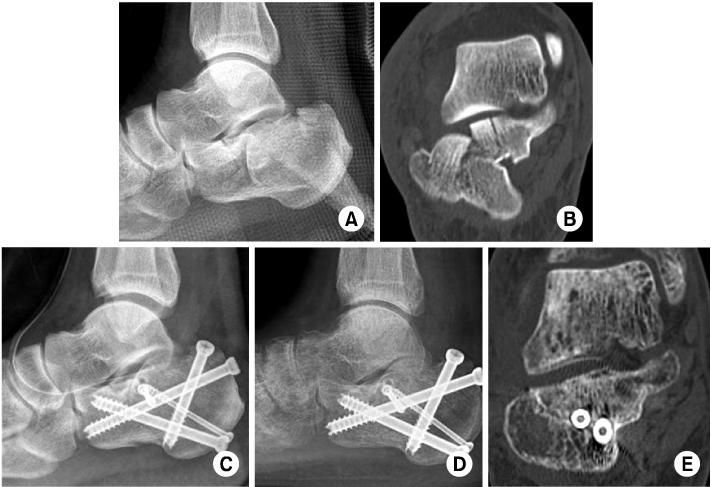J Korean Fract Soc.
2013 Apr;26(2):126-132. 10.12671/jkfs.2013.26.2.126.
The Result Treated by Open Reduction and Internal Fixation with Minimally Invasive Technique in Joint Depressive Calcaneal Fracture
- Affiliations
-
- 1Department of Orthopaedic Surgery, College of Medicine, Chosun University, Gwangju, Korea. leejy88@chosun.ac.kr
- KMID: 1496167
- DOI: http://doi.org/10.12671/jkfs.2013.26.2.126
Abstract
- PURPOSE
To evaluate the short term follow-up results of minimally invasive technique in the management of Sanders type II, III, and IV joint depressive calcaneal fracture.
MATERIALS AND METHODS
Between May 2008 and May 2011, we studied 17 cases undergoing treatment with minimally invasive technique with modified sinus tarsi approach for Sanders II, III, and IV joint depressive intra-articular calcaneal fracture and were followed up for more than 1 year. We evaluated the treatment result by assessing the radiologic parameters (Bohler angle, Gissane angle, and calcaneal height/width/length) and clinical outcomes (American Orthopaedic Foot and Ankle Society [AOFAS] score and visual analog scale [VAS]) and investigating the complication.
RESULTS
Radiological results improved from 7.9degrees to 19.8degrees in the Bohler angle after the operation. Satisfactory results were obtained in clinical assessment with average AOFAS score of 82.45 and the average VAS score of 3.94. We experienced 3 cases of complications, 1 case of superficial wound infection and radiologic findings of subtalar arthritis in 2 cases.
CONCLUSION
Minimally invasive technique may be a useful alternative surgical method in the management of Sanders type II, III, and IV joint depressive calcaneal fracture that cannot adopt extensile approach, which enable to obtain good radiological and clinical results.
Figure
Reference
-
1. Abidi NA, Dhawan S, Gruen GS, Vogt MT, Conti SF. Wound-healing risk factors after open reduction and internal fixation of calcaneal fractures. Foot Ankle Int. 1998. 19:856–861.
Article2. Allon SM, Mears DC. Three dimensional analysis of calcaneal fractures. Foot Ankle. 1991. 11:254–263.
Article3. Barei DP, Bellabarba C, Sangeorzan BJ, Benirschke SK. Fractures of the calcaneus. Orthop Clin North Am. 2002. 33:263–285.
Article4. Carr JB. Surgical treatment of intra-articular calcaneal fractures: a review of small incision approaches. J Orthop Trauma. 2005. 19:109–117.5. Chae SU, Yang JH. Minimally-invasive percutaneous screw fixation of displaced intra-articular calcaneal fractures. J Korean Foot Ankle Soc. 2010. 14:73–78.6. Chung HJ, Ahn JK, Bae SY, Jung H. Operative treatment of intraarticular calcaneal fractures using extensile lateral approach. J Korean Foot Ankle Soc. 2009. 13:60–67.7. Ebraheim NA, Elgafy H, Sabry FF, Freih M, Abou-Chakra IS. Sinus tarsi approach with trans-articular fixation for displaced intra-articular fractures of the calcaneus. Foot Ankle Int. 2000. 21:105–113.
Article8. Essex-lopresti P. The mechanism, reduction technique, and results in fractures of the os calcis. Br J Surg. 1952. 39:395–419.
Article9. Fernandez DL, Koella C. Combined percutaneous and "minimal" internal fixation for displaced articular fractures of the calcaneus. Clin Orthop Relat Res. 1993. (290):108–116.
Article10. Folk JW, Starr AJ, Early JS. Early wound complications of operative treatment of calcaneus fractures: analysis of 190 fractures. J Orthop Trauma. 1999. 13:369–372.
Article11. Freund M, Thomsen M, Hohendorf B, Zenker W, Heller M. Optimized preoperative planning of calcaneal fractures using spiral computed tomography. Eur Radiol. 1999. 9:901–906.
Article12. Guyer BH, Levinsohn EM, Fredrickson BE, Bailey GL, Formikell M. Computed tomography of calcaneal fractures: anatomy, pathology, dosimetry, and clinical relevance. AJR Am J Roentgenol. 1985. 145:911–919.
Article13. Harvey EJ, Grujic L, Early JS, Benirschke SK, Sangeorzan BJ. Morbidity associated with ORIF of intra-articular calcaneus fractures using a lateral approach. Foot Ankle Int. 2001. 22:868–873.
Article14. Kocis J, Stoklas J, Kalandra S, Cizmár I, Pilnỳ J. Intra-articular calcaneal fractures. Acta Chir Orthop Traumatol Cech. 2006. 73:164–168.15. Kundel K, Funk E, Brutscher M, Bickel R. Calcaneal fractures: operative versus nonoperative treatment. J Trauma. 1996. 41:839–845.16. Leung KS, Yuen KM, Chan WS. Operative treatment of displaced intra-articular fractures of the calcaneum. Medium-term results. J Bone Joint Surg Br. 1993. 75:196–201.
Article17. Meraj A, Zahid M, Ahmad S. Management of intra-articular calcaneal fractures by minimally invasive sinus tarsi approach-early results. Malay Orthop J. 2012. 6:13–17.
Article18. O'Farrell DA, O'Byrne JM, McCabe JP, Stephens MM. Fractures of the os calcis: improved results with internal fixation. Injury. 1993. 24:263–265.19. Paley D, Hall H. Intra-articular fractures of the calcaneus. A critical analysis of results and prognostic factors. J Bone Joint Surg Am. 1993. 75:342–354.
Article20. Palmer I. The mechanism and treatment of fractures of the calcaneus; open reduction with the use of cancellous grafts. J Bone Joint Surg Am. 1948. 30A:2–8.21. Rammelt S, Amlang M, Barthel S, Zwipp H. Minimally-invasive treatment of calcaneal fractures. Injury. 2004. 35:Suppl 2. SB55–SB63.
Article22. Randle JA, Kreder HJ, Stephen D, Williams J, Jaglal S, Hu R. Should calcaneal fractures be treated surgically? A meta-analysis. Clin Orthop Relat Res. 2000. (377):217–227.23. Sanders R. Displaced intra-articular fractures of the calcaneus. J Bone Joint Surg Am. 2000. 82:225–250.
Article24. Sanders R, Gregory P. Operative treatment of intra-articular fractures of the calcaneus. Orthop Clin North Am. 1995. 26:203–214.
Article25. Sangeorzan BJ, Benirschke SK, Carr JB. Surgical management of fractures of the os calcis. Instr Course Lect. 1995. 44:359–370.26. Shigemasa C, Abe K, Taniguchi S, et al. The influence of diabetes mellitus on thyrotropin response to thyrotropin-releasing hormone in untreated acromegalic patients. J Endocrinol Invest. 1988. 11:231–237.
Article27. Thordarson DB, Krieger LE. Operative vs: nonoperative treatment of intra-articular fractures of the calcaneus: a prospective randomized trial. Foot Ankle Int. 1996. 17:2–9.
Article28. Zwipp H, Rammelt S, Barthel S. Calcaneal fractures--the most frequent tarsal fractures. Ther Umsch. 2004. 61:435–450.
- Full Text Links
- Actions
-
Cited
- CITED
-
- Close
- Share
- Similar articles
-
- Open Reduction of Calcaneal Fracture
- Outcomes of Minimally Invasive Surgery in Intra-Articular Calcaneal Fractures: Sanders Type III, Joint Depressive Type Calcaneal Fracture
- Management of Displaced Intra-articular Calcaneal Fracture
- Classification and Evaluation of the Clinical Result of the Calcaneal Fracture Based on The Computed Tomography
- Open reduction and Internal Fixation of Calcaneus Fractures by Staples and Screws




